Here is this weeks collection of science news stories that triggered my “Hey, that’s cool” detector. As always, if I’ve missed anything that is truly cool, then drop a comment and I’ll do an update that includes a hat tip you.
In honor of the Pope’s visit to the UK, lets start with this one ..
Pope’s anti-condom message is sabotage in fight against Aids
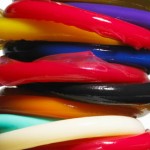 Stance makes Catholic church a major global public health problem
Stance makes Catholic church a major global public health problem
This week the pope is in London. You will have your own views on the discrimination against women, the homophobia, and the international criminal conspiracy to cover up for mass child rape. My special interest is his role in the 2 million people who die of Aids each year.
This is ludicrous. You, the Catholic church, is the only major influential international political organisation that actively tells people not to do something that works – on a huge scale. Your own figures show that your numbers are growing in Africa, even faster than the population does.
I’m happy for you to suggest abstention. But sabotaging an effective intervention which prevents a disease that kills 2 million people a year makes you a serious global public health problem.
Of mind and matter: David Attenborough meets Richard Dawkins
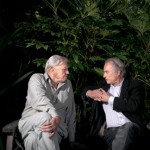 We paired up Britain’s most celebrated scientists to chat about the big issues: the unity of life, ethics, energy, Handel – and the joy of riding a snowmobile
We paired up Britain’s most celebrated scientists to chat about the big issues: the unity of life, ethics, energy, Handel – and the joy of riding a snowmobile
Sir David Attenborough, 84, is a naturalist and broadcaster. He studied geology and zoology at Cambridge before joining the BBC in 1952 and presenting landmark series including Life On Earth (1979), The Living Planet (1984) and, recently, Life. Richard Dawkins, 69, was educated at Oxford, later lectured there and became its first professor of the public understanding of science. An evolutionary biologist, he is the author of 10 books, including The Selfish Gene (1976), The God Delusion (2006) and The Greatest Show On Earth (2009). He is now working on a children’s book, The Magic Of Reality.
What is the one bit of science from your field that you think everyone should know?
David Attenborough: The unity of life.
Richard Dawkins: The unity of life that comes about through evolution, since we’re all descended from a single common ancestor. It’s almost too good to be true, that on one planet this extraordinary complexity of life should have come about by what is pretty much an intelligible process. And we’re the only species capable of understanding it.
Where and when do you do your best thinking?
DA: I’ve no idea. All I know is if I’m stuck with something and go to bed, I wake up with the answer.
RD: That’s a fascinating phenomenon, isn’t it?
DA: That’s if I find the answer at all.
RD: Very few people say, “I think I’ll have an hour’s thinking now.”
DA: Mathematicians do. I had an uncle who was a mathematician, and one of his students said, “How long can you think for?” He said, “I sometimes manage two or three minutes.” And this young man said, “I’ve never managed more than 90 seconds.” Of course, that’s abstract thinking, and by and large I’m not an abstract thinker.
What distracts you?
RD: The internet.
DA: I used to work to music, but I can’t now. Music is too important not to give it my full attention.
What problem do you hope scientists will have solved by the end of the century?
DA: The production of energy without any deleterious effects. The problem is then we’d be so powerful, there’d be no restraint and we’d continue wrecking everything. Solar energy would be preferable to nuclear. If you could harness it to produce desalination, you could make the Sahara bloom.
RD: I was thinking more academically: the problem of human consciousness.
Found: natural bridges on the moon
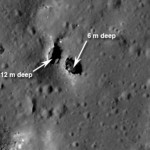 Natural bridges have been found on the moon for the first time in images taken by a high-resolution camera aboard NASA’s Lunar Reconnaissance Orbiter.
Natural bridges have been found on the moon for the first time in images taken by a high-resolution camera aboard NASA’s Lunar Reconnaissance Orbiter.
Students scrutinising the camera’s images have spotted two natural bridges on the moon’s far side. The larger bridge measures 20 metres long and 7 metres wide, while its smaller neighbour is about half that size.
Unlike natural bridges on Earth, which form largely by erosion from wind and water, these lunar bridges probably formed as a result of an impact in the last billion years, says Mark Robinson, a planetary geologist at Arizona State University in Tempe and principal investigator for LRO’s camera.
The impact melted the surface that it hit and gouged out a 77-kilometre-wide basin known as King crater. Some of the melted rock splashed over the crater’s rim, forming a fiery pool of liquid 17 kilometres across just outside the crater’s northwest rim.
New Scientist: Continue Reading …
How can we use neutrinos to probe dark matter in the Sun?
The existence of Dark Matter particles in the Sun’s interior seems inevitable, despite dark matter never having been observed (there or elsewhere), despite intensive ongoing searches. Once gravitationally captured by the Sun, these particles tend to accumulate in its core.
In a paper to be published in the scientific journal Science, Dr. Ilidio Lopes and Professor Joseph Silk propose that the presence of dark matter in the Sun’s interior causes a significant drop in its central temperature. Their calculations have shown that, in some dark matter scenarios, an isothermal solar core (constant temperature) is formed. The authors suggest that the neutrino detectors will be able to measure these types of effects.
In another paper published in The Astrophysical Journal Letters, the same authors suggest that, through the detection of gravity waves produced in the Sun’s interior (identical to internal sea waves), Helioseismology can also independently confirm the presence of Dark Matter in the Sun.
How Much Global Warming Is Guaranteed Even If We Stopped Building Coal-Fired Power Plants Today?
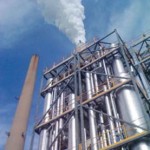 Humanity has yet to reach the point of no return when it comes to catastrophic climate change, according to new calculations. If we content ourselves with the existing fossil-fuel infrastructure we can hold greenhouse gas concentrations below 450 parts per million in the atmosphere and limit warming to below 2 degrees Celsius above preindustrial levels—both common benchmarks for international efforts to avoid the worst impacts of ongoing climate change—according to a new analysis in the September 10 issue of Science. The bad news is we are adding more fossil-fuel infrastructure—oil-burning cars, coal-fired power plants, industrial factories consuming natural gas—every day.
Humanity has yet to reach the point of no return when it comes to catastrophic climate change, according to new calculations. If we content ourselves with the existing fossil-fuel infrastructure we can hold greenhouse gas concentrations below 450 parts per million in the atmosphere and limit warming to below 2 degrees Celsius above preindustrial levels—both common benchmarks for international efforts to avoid the worst impacts of ongoing climate change—according to a new analysis in the September 10 issue of Science. The bad news is we are adding more fossil-fuel infrastructure—oil-burning cars, coal-fired power plants, industrial factories consuming natural gas—every day.
A team of scientists analyzed the existing fossil-fuel infrastructure to determine how much greenhouse gas emissions we have committed to if all of that kit is utilized for its entire expected lifetime. The answer: an average of 496 billion metric tons more of carbon dioxide added to the atmosphere between now and 2060 in “committed emissions”.
That assumes life spans of roughly 40 years for a coal-fired power plant and 17 years for a typical car—potentially major under- and overestimates, respectively, given that some coal-fired power plants still in use in the U.S. first fired up in the 1950s. Plugging that roughly 500 gigatonne number into a computer-generated climate model predicted CO2 levels would then peak at less than 430 ppm with an attendant warming of 1.3 degrees C above preindustrial average temperature. That’s just 50 ppm higher than present levels and 150 ppm higher than preindustrial atmospheric concentrations.
Still, we are rapidly approaching a point of no return, cautions climate modeler Ken Caldeira of the Carnegie Institution for Science’s Department of Global Ecology at Stanford University, who participated in the study. “There is little doubt that more CO2-emitting devices will be built,” the researchers wrote. After all, the study does not take into account all the enabling infrastructure—such as highways, gas stations and refineries—that contribute inertia that holds back significant changes to lower-emitting alternatives, such as electric cars.
Scientific American: Continue Reading …
Hubble Spies Oddly “Perfect” Celestial Spiral
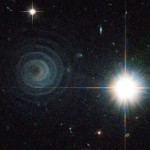 An unusually “perfect” cosmic corkscrew surrounds the binary star system LL Pegasi in a new Hubble Space Telescope picture released this week.
An unusually “perfect” cosmic corkscrew surrounds the binary star system LL Pegasi in a new Hubble Space Telescope picture released this week.
Astronomers think the spiral’s evenly spaced rings are being created because one of the stars in the binary pair is dying. Unlike more massive stars that end their lives in explosive supernovae, LL Pegasi is quietly shedding its outer layers of gas and dust to form what’s called a planetary nebula.
The dying star itself is still hidden by a dusty cocoon. But it’s ejecting material at about 31,000 miles (50,000 kilometers) an hour, the researchers calculate, forming a new ring in the spiral every 800 years.
“If a single star was sitting still, it would eject matter in all directions at roughly the same speed,” said Raghvendra Sahai of NASA’s Jet Propulsion Laboratory.
Creationists seek to insert their own brand of ‘truth’ into education
Being open to new ways of thinking should be encouraged. But blindly “teaching the controversy” shouldn’t
Thirty reasons why man is not descended from apes may seem an unlikely thing for children to learn on an educational school trip. But that’s just one of the treats in store at Noah’s Ark Zoo Farm, a creationist establishment near Bristol which was recently awarded a “quality badge” by the Council for Learning Outside the Classroom.
The council’s deputy chief executive, Elaine Skates, defended the decision by saying she believed that “an important aim of learning outside the classroom is allowing children and young people access to education that challenges assumptions and allows them to experience a range of viewpoints.”
What Skates is endorsing here, though probably unwittingly, is a notion known as “teach the controversy”. The term was coined by the Discovery Institute, America’s most notorious creationist organisation, as a means of arguing for the teaching of Biblical creation alongside evolution in US schools.
Operating ostensibly from the principle of free speech, its proponents argue that the purpose of education is to allow children to reach their own conclusions, as though there are no facts, and all knowledge is subjective.
Perhaps it sounds reasonable to be open-minded. But those arguing for “teach the controversy” in this area do so disingenuously – it’s a convenient way of inserting their own brand of “truth” into education.
There are controversies in all disciplines, including science. But the scientific “controversies” covered by the teach-the-controversy brigade tend to highlight problems that don’t actually exist. Just look at the examples provided by Answers in Genesis, a website run by Ken Ham who is also founder of Kentucky’s Creation Museum. Here you can learn why the Earth is 6,000 years old, or why “dinosaurs make perfect sense in light of the biblical history of creation and the Flood“.
Astronomer Unveils the Mysteries of ‘Green Pea’ Galaxies
 First discovered in 2007 by amateur stargazers, the strange so-called Green Pea galaxies have now been shown to be extraordinary and extremely compact star cities that have low amounts of complex elements after being diluted by streams of gas and strong supernova winds.
First discovered in 2007 by amateur stargazers, the strange so-called Green Pea galaxies have now been shown to be extraordinary and extremely compact star cities that have low amounts of complex elements after being diluted by streams of gas and strong supernova winds.
Presenting at the Joint European and National Astronomy Meeting (JENAM2010), lead scientist Ricardo Amorin said: “This Green Pea discovery is a fabulous example of how normal citizens, ‘astronomy lovers’, can help scientists with their collective efforts. They discuss the science with professional astronomers, and have written an excellent Wikipedia entry about Green Pea galaxies which presents a lot of information to people of the world.”
Green Pea galaxies were first classified by hobby stargazers. The online project Galaxy Zoo and Galaxy Zoo 2 asked interested members of the public to help sort through a vast depository of night sky images produced by the Sloan Digital Sky Survey. Categorising galaxy types is both important to learn about the evolution of the Universe, and also difficult because of the ambiguous shape of many. Astronomers turned to the online community for help, and citizen scientists flocked to sift through the images and look for galaxy types. Within 24 hours of launch the site was receiving an astonishing 70,000 classifications an hour.
These citizen scientists discovered a strange type of galaxy that did not fit with previously known types. Small in size and green in colour, they were soon named “Green Pea” galaxies. They appear to be compact low-mass galaxies undergoing intense star formation, and being around 1.5 to 5 billion years distant indicates that this is a brief but extreme stage of their evolution.
Green Pea galaxies are now known to be “metal-poor”; metals in this astronomical sense meaning any element other than hydrogen and helium. The study presented today suggests that gas gravitationally attracted from the outskirts of the Green Pea galaxies or beyond, combined with shockwaves from supernova explosions, are likely causes. Amorin explains: “Discovering Green Pea galaxies has opened a new window to investigate galaxy evolution and star formation in the early Universe.”
Science Daily: Continue Reading …
Why some memories stick
Practice makes perfect when it comes to remembering things, but exactly how that works has long been a mystery. A study published in the September 10 issue of Science indicates that reactivating neural patterns over and over again may etch items into the memory.
People find it easier to recall things if material is presented repeatedly at well-spaced intervals rather than all at once. For example, you’re more likely to remember a face that you’ve seen on multiple occasions over a few days than one that you’ve seen once in one long period. One reason that a face linked to many different contexts–such as school, work and home–is easier to recognize than one that is associated with just one setting, such as a party, could be that there are multiple ways to access the memory. This idea, called the encoding variability hypothesis, was proposed by psychologists about 40 years ago.
Each different context or setting activates a distinct set of brain regions; the hypothesis suggests that it is these differing neural responses that improve the memory. But neuroimaging research led by Russell Poldrack, a cognitive neuroscientist at the University of Texas, Austin, now suggests that the opposite is true–items are better remembered when they activate the same neural patterns with each exposure.
Scientific American: Continue Reading …
New NASA Probe to Dive-bomb the Sun
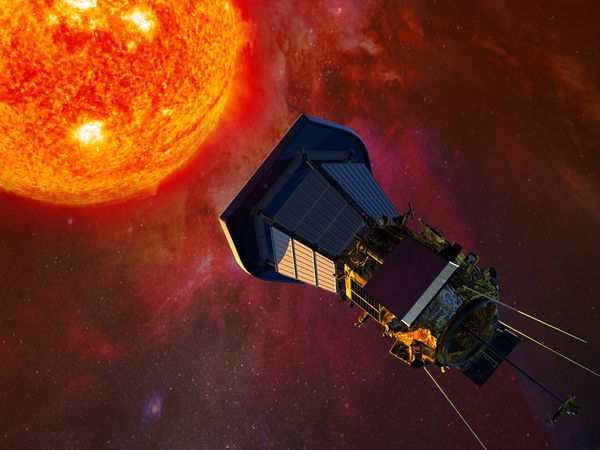 First NASA “bombed” the moon in search of water ice. Now the space agency says it will send a craft diving into the sun to take direct samples from our star for the first time.
First NASA “bombed” the moon in search of water ice. Now the space agency says it will send a craft diving into the sun to take direct samples from our star for the first time.
Last week NASA mission managers behind the planned Solar Probe Plus made their final picks for the scientific experiments that will hitch a ride on the compact car-size spacecraft.
Slated to launch no later than 2018, Solar Probe Plus will repeatedly plunge through the sun’s superhot outer atmosphere, called the corona, coming as close as 4 million miles (6.5 million kilometers) from the star’s fiery surface.
“This promises to be one of the most daring and dangerous space missions ever attempted,” said Dave McComas of the Southwest Research Institute in San Antonio, Texas, one of the principal investigators on the mission.
“Our star is the dominant force in the solar system, with streams of charged particles blown out by its solar wind that create space weather that affects our planet—everything from auroras to knocking out our electrical grids and even satellites.”
(See “Space Weather Could Scrub Manned Mars Mission.”)
Over its three-year mission, Solar Probe Plus will swing by Venus on its way to orbit the sun, where it will swoop through the corona up to 24 times.
Carbon-based Heat Shield Key to Dive-bombing Probe
The probe’s first pass by the sun will occur two months after launch, at a distance of 15 million miles (24 million kilometers) from the star.
Over the next several years, swing-bys of Venus will slowly tweak the probe’s trajectory, so that Solar Probe Plus gradually gets closer to the sun during each successive orbit. By 2024 the probe’s path will be eight times closer to the sun than the orbit of Mercury.
National Geographic: Continue reading …
A Bit Cold: Physicists Devise a Quantum Particle “Refrigerator”
 Call it the little chill. A group of theoretical physicists has mapped out the physics framework for what may be the smallest refrigerators imaginable. Each device would target just one quantum bit, or qubit, for cooling, and would require just one or two additional quantum particles to do the job.
Call it the little chill. A group of theoretical physicists has mapped out the physics framework for what may be the smallest refrigerators imaginable. Each device would target just one quantum bit, or qubit, for cooling, and would require just one or two additional quantum particles to do the job.
Theoretical physicists Noah Linden and Sandu Popescu, along with graduate student Paul Skrzypczyk, all of the University of Bristol in England, describe their concept in a paper to be published in Physical Review Letters. If it can be implemented, the work could find use in preparing qubits, which are often single atoms, for use in quantum-information systems by initializing them to a known state.
The model is in some sense simply a scaled-down version of the refrigerators humming away in kitchens around the world—it has an engine qubit to drive the cooling process and a heat-coil qubit to vent the heat drawn away from the refrigerator’s contents (the qubit to be chilled) to the outside world.
Just as with classical bits in everyday electronic devices, each qubit can be 0 or 1, as represented by the individual qubit’s energy level. (Thanks to the fundamental quirks of quantum mechanics, a qubit can also be in a superposition, existing simultaneously as 0 and 1.) Each qubit requires a certain amount of energy to move from 0 to 1, known as its energy level spacing. (An even smaller concept for the fridge condenses the engine and the coil into a single particle with three energy levels, known as a qutrit.)
In the Bristol group’s theoretical depiction, crucially, the energy level spacing of the qubit to be cooled and that of the refrigerator’s “engine” together add up to exactly the energy level spacing of the refrigerator’s “heat coil.” In other words, exciting (heating) both the engine and the fridge contents takes just as much energy as exciting the coil alone. Because of that condition, the two states—excited coil or excited engine and contents—can alternate at ease, making each scenario just as likely as the other, all things being equal.
Scientific American: Continue reading …
ADDITION-1: With a hat Tip to emedist.com
Blood Signatures to Diagnose Infection
Coughing and wheezing patients could someday benefit from quicker, more accurate diagnosis and treatment for respiratory infections such as flu, through a simple blood test, according to scientists.
Dr. Aimee Zaas, presenting her work at the Society for General Microbiology’s autumn meeting in Nottingham describes how simply looking at an individuals blood ‘signature’ can be used to quickly diagnose and treat ill patients and could even predict the onset of a pandemic.
The team, from the Duke Institute for Genome Sciences & Policy and Duke University Medical Center in the US, looked at the blood of otherwise healthy individuals who had been exposed to rhinovirus, respiratory syncytial virus or influenza. The team found each viral infection stimulated the body to produce a very specific set of immune molecules that could be detected in the blood. Recording the distinct blood signatures for each virus in a database and matching them against blood samples from other ill patients pinpointed the cause of disease with more than 95% accuracy.
Respiratory infections, including colds and flu are a common reason for seeking medical help. As Dr. Zaas highlighted, “Current methods for accurate diagnosis are time and labour intensive and are not always accurate. This means GPs are sometimes overcautious and may prescribe antibiotics unnecessarily, for viral infections. During a pandemic, this has real consequences as there is an increased risk of spreading infection.”
Dr. Zaas explained how her test works completely differently to current diagnostic tests as it analyses each individual’s immune response to infection, rather than the actual micro-organism responsible. “We effectively look at the imprint in the blood that the virus makes, which is as individual as a signature,” she said. “Not only is this much more accurate than traditional testing, it also works much faster as it can be done through a simple blood test.”
great blog thank you